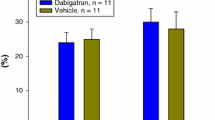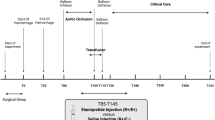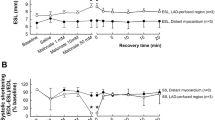Summary
The effects of an intracoronary infusion of superoxide dismutase on infarct size were studied in 16 pigs submitted to a 48-min coronary occlusion of the mid left anterior descending coronary artery followed by reperfusion for 24 h. Areas at risk marked with fluoresccine and infarct sizes calculated with triphenyl tetrazolium chloride staining 24 h after the occlusion were similar in the five control animals with coronary reperfusion alone, in the five animals with an intracoronary infusion of lactate Ringer initiated 3 min before reperfusion and maintained for 33 min and in the six animals with superoxide dismutase added to the solution of lactate Ringer and infused at a rate of 2500 units/min. The ratios infarct size/area at risk were respectively 0.50±0.10, 0.63±0.10 and 0.65±0.04 in the three study groups (NS). The extent of intramyocardial hemorrhage, evaluated by morphometric analysis was also similar 0.90±0.29×106, 0.70±0.14 and 1.62±0.42 red blood cells/mm3 of tissue (NS). The superoxide dismutase infusion, however, resulted in significantly fewer early reperfusion arrhythmias which involved 23±15 s of each minute electrocardiographic recording in the superoxide dismutase group, compared to 37±13 s in the lactate Ringer group and 45±14 s in the control group (p=0.004). The lack of an effect of intracoronary infusion of superoxide dismutase on infarct size suggests that in this experimental model, extracellular superoxide radicals generated during early reperfusion have no major role on myocardial cell necrosis and microvascular damage. Reperfusion arrhythmias were, however, reduced.
Similar content being viewed by others
References
Ambrosio G, Becker LC, Hutchins GM, Weisman HE, Weisfeldt ML (1986) Reduction in experimental infarct size by recombinant human superoxide dismutase: insights into the pathophysiology of reperfusion injury. Circulation 74:1424–1433
Ambrosio G, Zweier JL, Jacobus WE, Weisfeldt ML, Flaherty JT (1987) Improvement of postischemic myocardial function and metabolism induced by administration of deferoxamine at the time of reflow: the role of iron in the pathogenesis of reperfusion injury. Circulation 76:906–915
Bernier M, Hearse DJ, Manning AS (1986) Reperfusion-induced arrhythmias and oxygen-derived free radicals. Studies with “anti-free radical” interventions and a free radical generating system in the isolated perfused rat heart. Circ Res 58:331–340
Bolli R, Zhu W, Hartley CJ, Michael LH, Repine JE, Hess ML, Kukreja RC, Roberts R (1987) Attenuation of dysfunction in the postischemic “stunned” moycardium by dimethylthiourea. Circulation 76:458–468
Das DK, Engelman RM, Rouson JA, Breyer RH, Otani H, Lemeshow S (1986) Pathophysiology of superoxide radical as potential mediator of reperfusion injury in pig heart. Basic Res Cardiol 81:155–166
de Lorgeril M, Rousseau G, Basmadjian A, Latour JG (1988) Lignocaine in experimental myocardial infarction: failure to prevent neutrophil accumulation and ventricular fibrillation and to reduce infarct size. Cardiovasc Res 22:439–446
Eddy LJ, Stewart JR, Jones HP, Engerson TD, McCord JM, Downey JM (1987) Free radical producing enzyme, xanthine oxidase, is undetectable in human hearts. Am J Physiol 253:H709-H711
Engler R, Covell JW (1987) Granulocytes cause reperfusion ventricular dysfunction after 15-minute ischemia in the dog. Circ Res 61:20–28
Engler R, Gilpin E (1989) Can superoxide dismutase alter myocardial infarct size? Circulation 79:1137–1142
Forman MB, Puett DW, Cates CU, McCroskey DE, Beckman JK, Greene HL, Virmani R (1988) Glutathione redox pathway and reperfusion injury. Effect of N-Acetylcysteine on infarct size and ventricular function. Circulation 78:202–213
Fujiwara H, Ashraf M, Sato S, Millard RW (1982) Transmural cellular damage and blood flow distribution in early ischemia in pig hearts. Circ Res 51:683–693
Fuster V, Frye RL, Kennedy MA, Connoly DC, Mankin HT (1979) The role of collateral circulation in the various coronary syndromes. Circulation 59:1137–1144
Gallagher KP, Buda AJ, Pace D, Gerren RA, Shlafer M (1986) Failure of superoxide dismutase and catalase to alter size of infarction in conscious dogs after 3 hours of occlusion followed by reperfusion. Circulation 73:1065–1076
Garcia-Dorado D, Théroux P, Desco M, Solares J, Elizaga J, Fernandez-Avilés F, Alonso J, Soriano J (1989) Cell-to-cell interaction: a mechanism to explain the wavefront progression of myocardial necrosis. Am J Physiol 256:H1266–1273
Garcia-Dorado D, Théroux P, Elizaga J, Fernandez-Avilés F, Alonso J, Solares J (1988) Influence of tachycardia and arterial hypertension on infarct size in the pig. Cardiovasc Res 22: 620–626
Garcia-Dorado D, Théroux P, Elizaga J, Galinanes M, Solares J, Riesgo M, Gomez MJ, Garcia-Dorado A, Fernandez-Avilés F (1987) Myocardial reperfusion in the pig heart model: infarct size and duration of coronary occlusion. Cardiovasc Res 21:537–544
Garcia-Dorado D, Théroux P, Fernandez-Avilés F, Elizaga J, Solares J, Galinanes M (1987) Diltiazem and progression of myocardial ischemic damage during coronary artery occlusion and reperfusion in porcine hearts. J Am Coll Cardiol 10:906–911
Garcia-Dorado D, Théroux P, Solares J, Alonso J, Fernandez-Avilés F, Elizaga J, Soriano J, Botas J, Munoz R (1990) Determinants of hemorrhagic infarcts. Histologic observations from experiments involving coronary occlusion, coronary reperfusion and reocclusion. Am J Pathol 137:301–311
Garlick PB, Davies MJ, Hearse DJ, Slater TF (1987) Direct detection of free radicals in the reperfused rat heart using electron spin resonance spectroscopy. Circ Res 61:757–760
Hattori N, Drury JK, Satomura K, Miyazaki A, Corday E (1987) Reduction of infarct size with retrograde but not antegrade administration of superoxide dismutase in pigs (abstr). Circulation 76 (Suppl IV):200
Jully SR, Kane WJ, Bailie MB, Abrams GD, Lucchesi BR (1984) Canine myocardial reperfusion injury. Its reduction by the combined administration of superoxide dismutase and catalase. Circ Res 54:277–285
Karagucuzian HS, Mandel WJ (1987) Electrophysiologic mechanisms of ischemic ventricular arrhythmias. In: Mandel WJ (ed) Cardiac arrhythmias, their mechanisms, diagnosis and management. Lippincott JB Co., Philadelphia, pp 452–474
Kim M, Akera T (1987) O2 free radicals: cause of ischemia reperfusion injury to cardiac Na+−K+-ATPase. Am J Physiol 252:H252-H257
Kinsman III JM, Murry CE, Richard VJ, Jennings RB, Reimer KA (1988) The xanthine oxidase inhibitor oxypurinol does not limit infarct size in a canine model of 40 minutes of ischemia with superfusion. J Am Coll Cardiol 12:209–217
Kusuma Y, Bernier M, Hearse DJ (1989) Singlet oxygen-induced arrhythmias. Circulation 80:1430–1448
Limm WM, Mugilishi MM, Schwartz SM, McNamara J (1988) Oxygen free radical scavengers do not reduce infarct size in baboons (abstr). J Am Coll Cardiol 11:163A
Luber JM, Rujikarn N, Rao PS (1987) Generation of free radicals during myocardial ischemia and reperfusion time course and identity (abstr). Circulation 76 (Suppl IV):199
McCord JM (1984) Are free radicals a major culprit? In: Hearse DJ, Yellow DM (eds) Therapcutic approaches to myocardial infarct size limitation. Raven Press, New York, pp 209–218
McDonagh PF, Reynolds JM (1987) Transcoronary exchange during reperfusion after myocardial ischemia. In: McDonagh PF (ed) microvascular perfusion and transport in health and disease. Skarger Publisher, Basel, pp 169–203
Mitsos SE, Askew TE, Fantone JC, Kunel SL, Abrams GD, Schork A, Lucchesi BR (1986) Protective effects of N-2-mercaptopropionyl glycine against myocardial reperfusion injury after neutrophil depletion in the dog: evidence for the role of intracellular-derived free radicals. Circulation 73:1077–1086
Muxfeldt M, Schaper W (1987) The activity of xanthine oxidasenin in heart of pigs, guinca pigs, rabbits, rats and humans. Basic Res Cardiol 82:486–492
Myers ML, Bolli R, Lekich RF, Hartley CJ, Roberts R (1985) Enhancement of recovery of myocardial function by oxygen free-radical scavengers after reversible regional ischemia. Circulation 72:915–921
Naslund U, Marklund S, Reiz S (1988) Superoxide dismutase limits myocardial infarct size in a porcine closed chest ischemia-reperfusion model (abstr). J Am Coll Cardiol 11:163A
Nejima J, Knight DR, Fallon JT, Uemura N, Manders WT, Canfield DR, Cohen MV, Vatner SF (1989) Superoxide dismutase reduces reperfusion arrhythmias but fails to salvage regional function or myocardium at risk in conscious dogs. Circulation 79:143–153
Pallandi RT, Perry MA, Campbell TJ (1987) Proarrhythmic effects of an oxygen-derived free radicals generating system on action potentials recorded from guinea pig ventricular myocardium: A possible cause of reperfusion induced arrhythmias. Circ Res 61:50–54
Peck SL, Johnston RB Jr, Horowitz LD (1985) Reduced neutrophil superoxide anion release after prolonged infusions of lidocaine. J Pharmacol Exp Ther 235:418–422
Przyklenk K, Kloner RA (1986) Superoxide dismutase plus catalase improve contractile function in the canine model of the “stunned myocardium”. Circ Res 58:148–156
Przyklenk K, Kloner RA (1989) “Reperfusion Injury” by oxygen-derived free radicals? Effect of superoxide dismutase plus catalase, given at the time of reperfusion, on myocardial infarct size, contractile function, coronary microvasculature, and regional myocardial blood flow. Circ Res 64:86–96
Puett DW, Forman MB, Cates CU, Wilson BH, Hande KR, Friesinger GC, Virmani R (1987) Oxypurinol limits myocardial stunning but does not reduce infarct size after reperfusion. Circulation 76:678–686
Reimer KA, Jennings RB (1985) Failure of the xanthine oxidase inhibitor allopurinol to limit infarct size after ischemia and reperfusion in dogs. Circulation 71:1069–1075
Richard VJ, Murry CE, Jennings RB, Reimer KA (1988) Therapy to reduce free radicals during early reperfusion does not limit the size of myocardial infarcts caused by 90 minutes of ischemia in dogs. Circulation 78:473–480
Schaper W, Binz K, Sass S, Winkler B (1987) Influence of collateral blood flow and of variations in MVO2 on tissue—ATP content in ischemic and infarcted myocardium. J Moll Cell Cardiol 19:19–25
Simpson PJ, Fantone JC, Mickleson JK, Gallagher KP, Lucchesi BR (1988) Identification of a time window for therapy to reduce experimental canine myocardial injury: suppression of neutrophil activation during 72 hours of reperfusion. Circ Res 63:1070–1079
Snyder DW, Crafford WA, Glashow JL, Rankin D, Sobel BE, Corr PB (1981) Lysophosphoglycerides in ischemic myocardium effluents and potentiation of their arrhythmogenic effects. Am J Physiol 241:H700-H707
Tamura Y, Chi L, Driscoll EM, Hoff PT, Freeman BA, Gallagher KP, Lucchesi BR (1988) Superoxide dismutase conjugated to polyethylene glycol provides sustained protection against myocardial ischemia/reperfusion injury. Circ Res 63:944–959
Thompson JA, Hess ML (1986) The oxygen free radical system: a fundamental mechanism in the production of myocardial necrosis. Prog Cardiovasc Dis 28:449–462
Tranum-Jansen J, Janse MJ, Fiolet JWT, Krieger WJG, Neumann d'Alnoncourt C, Durrer D (1981) Tissue osmolality, cell swelling and reperfusion in acute regional myocardial ischemia in the isolated porcine heart. Circ Res 49:364–387
Uraizee A, Reimer KA, Murry CE, Jennings RB (1987) Failure of superoxide dismutase to limit size of myocardial infarction after 40 minutes of ischemia and 4 days of reperfusion in dogs. Circulation 75:1237–1248
Werns SW, Grum CM, Ventura A, Lucchesi BR (1987) Effect of allopurinol or oxipurinol on myocardial reperfusion injury (abstr). Circulation 76 (Suppl IV):197
Werns SW, Shea MJ, Driscoll EM, Cohen C, Abrams GD, Pitt B, Lucchesi BR (1985) The independent effects of oxygen radical scavengers on canine infarct size. Reduction by superoxide dismutase but not catalase. Circ Res 56:895–898
Werns SW, Shea MJ, Mitsos SE, Dysko RC, Fantone JC, Schork MA, Abrams GD, Pitt B, Lucchesi BR (1986) Reduction of the sizc of infarction by allopurinol in the ischemic-reperfused canine heart. Circulation 73:518–524
Zweier J (1988) Measurement of superoxide-derived free radicals in the reperfused heart. Evidence for a free radical mechanism of reperfusion injury. J Biol Chem 263:1353–1357
Author information
Authors and Affiliations
Additional information
Partially supported by a grant PA 86/0389 from the Comisión Interministerial de Ciencia y Tecnología (CICYT), grant 1/86 from the Sección de Cardiopatía isquemica de la Sociedad Española de Cardiología and grant 17/88 of the Convenio Madrid-Quebec.
Rights and permissions
About this article
Cite this article
Garcia-Dorado, D., Théroux, P., Alonso, J. et al. Intracoronary infusion of superoxide dismutase and reperfusion injury in the pig heart. Basic Res Cardiol 85, 619–629 (1990). https://doi.org/10.1007/BF01907896
Received:
Issue Date:
DOI: https://doi.org/10.1007/BF01907896




